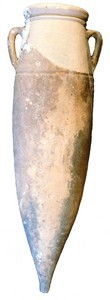Roman Amphorae: a digital resource
University of Southampton, 2005. (updated 2014) https://doi.org/10.5284/1028192. How to cite using this DOI
Data copyright © University of Southampton unless otherwise stated
This work is licensed under the ADS Terms of Use and Access.
Primary contact
Dr
David
Williams
Dept of Archaeology
University of Southampton
Avenue Campus
Highfield
Southampton
SO17 1BJ
England
Tel: 080 593032
Resource identifiers
- ADS Collection: 463
- DOI:https://doi.org/10.5284/1028192
- How to cite using this DOI
Dressel 21-22

Courtesy of Bodrum Museum of Underwater Archaeology
Donald Frey
Distinctive FeaturesThis has a wide mouth normally with a single, sometimes a double rounded rim underneath which there is a deep groove. The handles are oval-shaped with a broad neck cylindrical body and solid spike. Panella (2002: 252, Nos. 9 and 10) distinguishes two subtypes, one slightly smaller and slimmer than the other with less arched handles and a junction between shoulder and body.See characteristics | ||
Date RangeThe earliest date is no later than the last quarter of the first century BC (Van der Werff, 1986: 114; Hesnard, 1980: 150 and Note 100 (Longarina). The latest date is to the end of the first century AD.Search: [1st century BC] [1st century AD] | ||
OriginTituli picti suggest an origin in Italy, possibly in Campania or Lazio (Zevi, 1966; Panella, 2002), a conclusion borne out by petrological analysis (see below), while it has also been suggested that the form may also have been produced along the Adriatic coast and in Bruttium(Panella, forthcoming). The form also seems to have been copied on a small scale in Baetica (Sotomayor, 1969; Étienne & Mayet, 1994; Mayet, 1999), and in Tarraconensis (Beltrán Lloris, 2000: 450).Search: [Italy] [North West Europe] [Spain] [Western Mediterranean] | ||
DistributionCentral Italian production seems to have been distributed within Tyrrhenian Italy and in north Africa (Carthage), while that in the Adriatic is distributed to Sicily and the eastern Mediterranean (Panella & Moizio, forthcoming).Search: [Eastern Mediterranean] [Italy] [North Africa] [Tunisia] | ||
ContentsTituli picti from Pompeii suggest that amongst other commodities, this amphora type may have carried fruit: apples, cherries from Cuma and honey (Callender, 1965; Zevi, 1966; Panella, 2002). It has been suggested that the southern Spanish version may have carried garum (Etienne & Mayet, 1994).Search: [Fish Sauce] [Fruit] [Honey] | ||
CommentsPrincipal contributors: David Williams and Clementina Panella | ||
ClassificationCallender 4Ostia 54 Peacock & Williams 7 Schoene 4 | ||
CEIPAC linkThe following link will take you to the Centro para el Estudio de la Interdependencia Provincial en la Antiguedad Clásica CEIPAC database. In the CEIPAC system this amphora has the ID KE51+BYZ. Note: access to CEIPAC requires registration, which is possible via http://ceipac.ub.edu/corpus_reg.php?IDM=e | ||



 3D models
3D models


